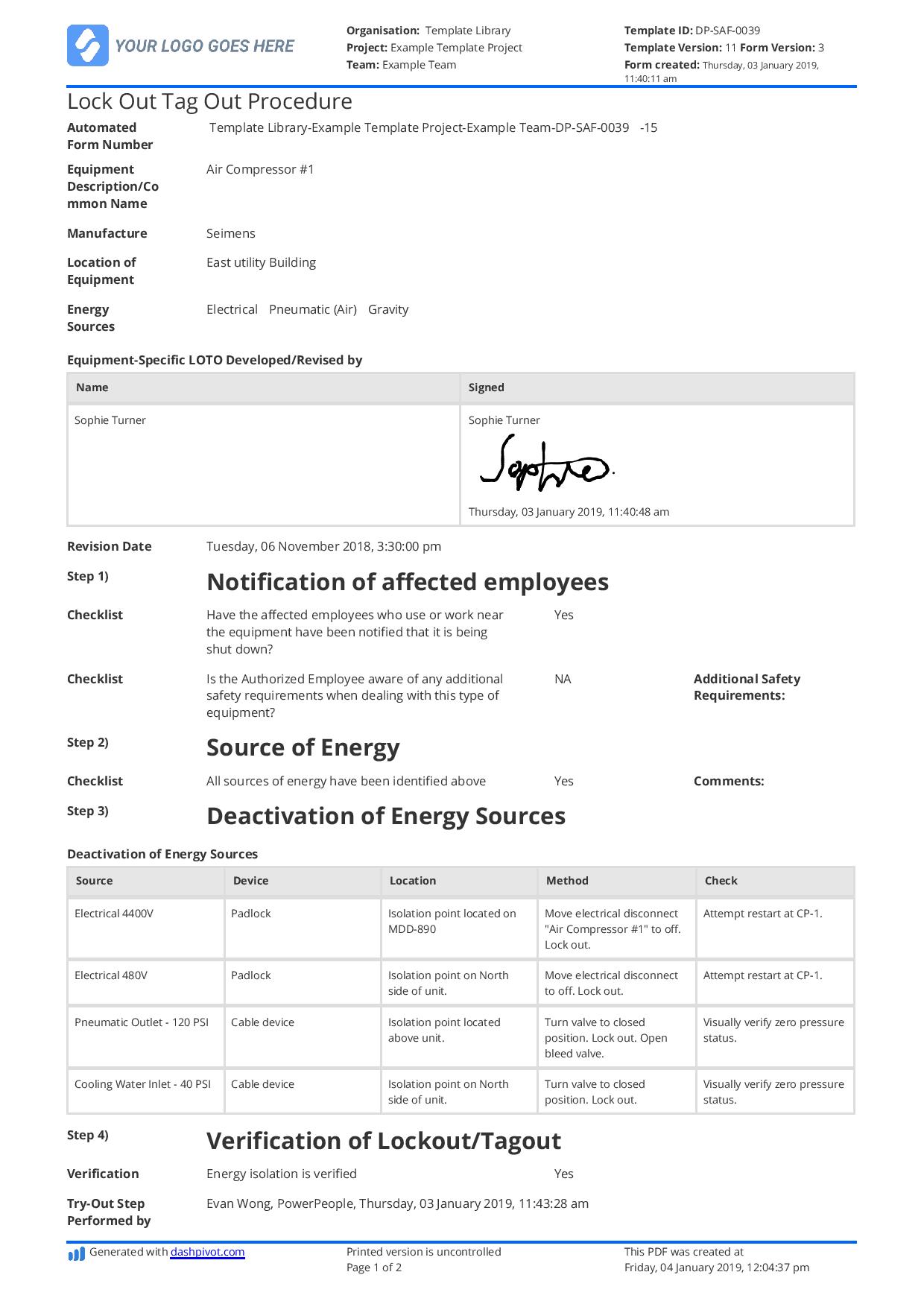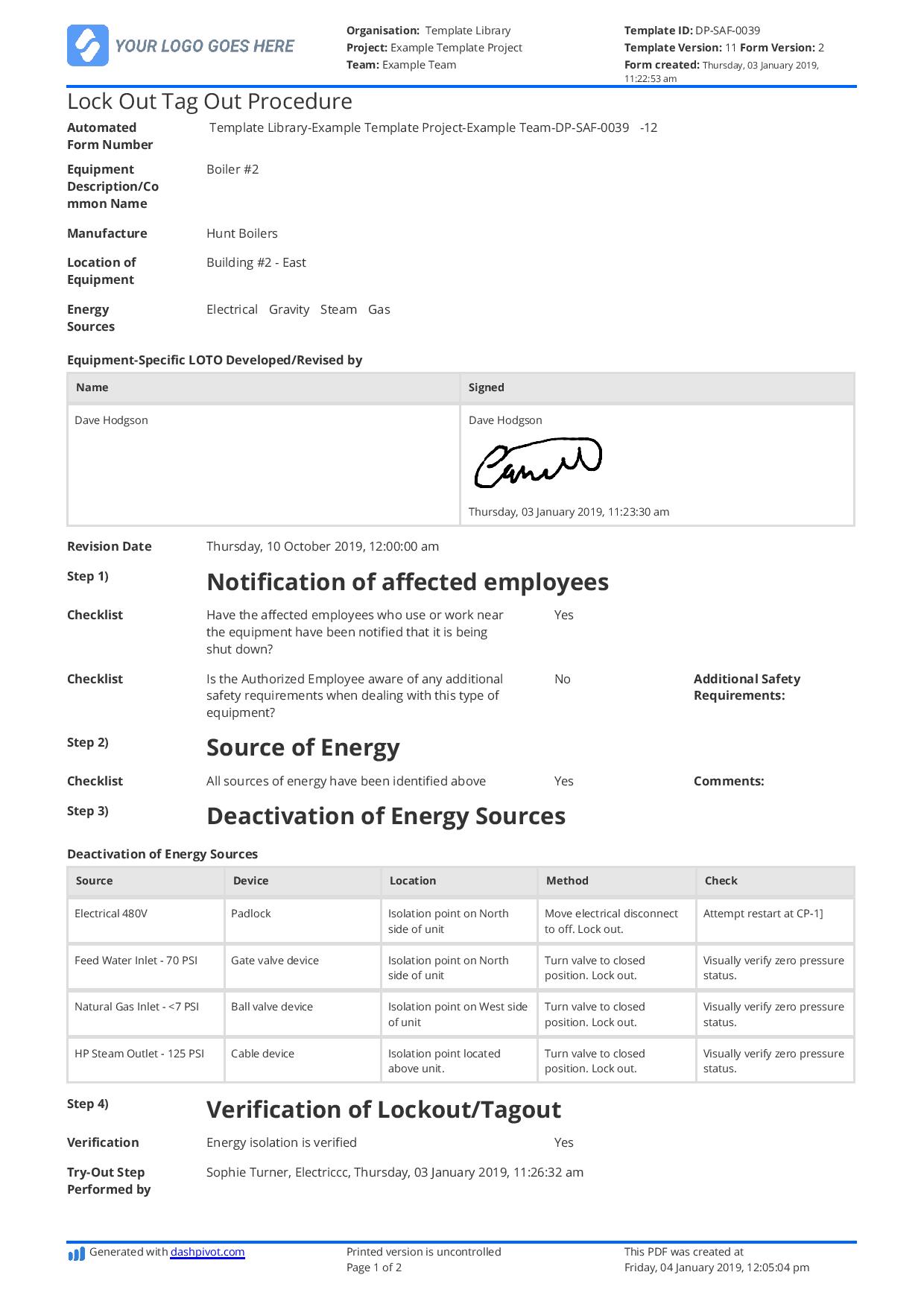Safety – Lock out tag out procedure

Here's a proven lock out tag out procedure for you
What is a lock out tag out?
A lock out tag out refers to the procedure and practice of disconnecting and isolating equipment and machinery to prevent the release of hazardous energy or the unexpected re-energisation of that machine or equipment.
Lock out tag outs (also commonly written down as LOTO) are performed by companies across a number of industries, including manufacturing, construction, oil and gas, mining and more.
The purpose of a lock out tag out is to keep the people performing work on a piece of equipment or machinery safe, as well as to prevent the machine or equipment from getting damaged.
Lock and tag outs are conducted when a number of different works are performed on highly energised and potentially dangerous equipment including:
- General maintenance
- Performing a service
- Replacing parts etc.
A lock out tag out should occur when any of these works occurs where there is the potential release of hazardous energy.
How the lock out and tag out differs from simply switching a a piece of equipment off is that the designated electrician or worker who is performing the lock and tag out either, you guessed it, locks the energy-isolating device (safety blocks, line valves, disconnect switches, manually operated circuit breakers etc.) - or tags it with a 'tag' or label.
The lockout device ensures that the energy isolating device remains in the off position no matter what happens.
Lock outs are obviously more secure than tag outs, with lock outs involving a lock or padlock which requires a great deal of effort to remove without the key which the locker typically holds onto - while a standalone tagout will simply involve a prominently labelled tag which hangs off or on the machine or equipment on the 'on' handle or similar, warning other employees to not touch or deal with this piece of equipment.
Why is your lock out tag out procedure important?
Following the right lock out tag out procedure is critical to worker safety in industries fraught with hazardous energy at every turn. When a standardised and reliable lock out tag out procedure isn't followed by your company and people, you leave margin for potentially fatal error.
A good lock out tag out procedure must explain what employees must know in order to perform a safe LOTO, and provide a framework and series of steps which every lock and tag out must follow.
Some companies codify their lock out tag out procedure into a single standardised document, while others who work in environments with more variety - various machines, - may find it helpful to separate and create multiple lock out tag out procedures which are applicable to each use case.
The two lock out tag out samples you see below follow the former method. This lock out tag out procedure is laid out in a single lock out tag out procedure, which every worker who engages in a LOTO accesses, completed and signs off on.
This way, the company can be sure that the right procedure is being followed every time, and every designated worker has a consistent framework with which to operate safely in.
Lock out tag out procedure sample - Air compressor
This lockout tag out procedure sample was conducted for an air compressor lock out.
In this sample, you can think of the LOTO procedure and this LOTO form being one and the same. Every time a LOTO is performed, these 6 steps are followed and the information captured on the form is the proof and detail of the lock and tag out.
There are a number of important elements or 'fields' in this lock out tag out procedure, starting with some basic record keeping information.
In most countries, there is safety legislation surrounding machinery and equipment isolations and lock and tag outs featuring hazardous levels of energy. Because of this, it's critical that your lock out and tag out procedure is properly documented for auditing and legal purposes.
Every time someone follows your LOTO procedure or fills out a form like this sample, they need to include requisite record keeping information including:
- A unique form number
- The equipment description and manufacturer
- The location of the equipment
- The type of energy sources involved in and released from this machine or piece of equipment
- The person who developed and revised this LOTO
While this detail may seem obvious, many companies forget to include it or omit it accidentally, which can cause havoc when conducting internal or external audits - or when simply trying to find a specific piece of information.
The next stage of the lock out and tag out procedure and the classified step 1 is to notify the affected employees. Lock out and tag outs like many safety issues are not confined to endangering one person. A project or piece of work on an industrial site can usually impact multiple people. It's important that in addition to visual tags and locks, people are aware of what's happening in their work environment - and if there are any additional safety precautions or requirements they should take.
Steps 2 and 3 are all about confirming and then deactivating the energy sources. Step 2 ensures that the designated lock and tag out person has identified all sources of energy - while step 3 involves the actual deactivation and checking of those energy sources.
In this procedure sample, a table is used for each energy source - which is an effective way to organise it. This way each energy source is captured, along with all of the important lock and tag out procedural elements including the device used, the location of the isolation point, the method of isolation and a final check to ensure it has been successfully isolated.
Step 4 is another critical step in the procedure: the verification of the lockout or tagout. This phase usually involves a final check of the equipment/machine and of the deactivation table - before a designated person perform a try-out step (tries to re-energise the machine or equipment).
Step 5 is the sign-off step, whereby the person who performed the lock out tag out signs the procedural form and declares that they are trained and authorised to conduct this procedure safely.
And finally, the last piece of the puzzle and the last section of this sample procedure (step 6) is to re-energise the equipment once the works have been performed and completed.

Use and customise this lock out tag out procedure sample for yourself.
Lock out tag out procedure sample - Boiler
There's another lock out tag out procedure sample for you to run your eyes over below. You'll notice that the framework is just as applicable and easy to fill out for a boiler as it was for the air compressor.
Components of the form itself (like tables) are flexible enough to handle any energy source and important details regardless of the type of machine or equipment being used.
Scan through the sample below to take another look at this LOTO procedure.

Improving lock out tag out safety
Like many elements of industrial and site safety, lock out and tag outs are vital but often difficult to coordinate and manage - and these difficulties impact the safety of your people and the reputation of the company.
There are a few major and tangible ways of improving lock and tag out safety - starting with the process for your procedure.
While your procedure may be sound - if the implementation of that procedure into an actual process which can be followed on site is poor, then your procedure will often not be followed nor recorded properly.
Hanging your lock out tag out procedure on the wall and keeping a stock of lock out tag out checklists in the office isn't the most efficient or safest way to manage lock and tag outs.
A proven way to improve these manual and often inefficient process is through technology - most often in the form of software and apps.
As an example of how technology can improve your lock out tag out safety, using a lockout tagout software, your lock out tag out procedure could look more like this:
- You setup a standardised LOTO procedure like the samples you saw above
- Every person performing a lock and tag out can instantly access, open and complete the lock out tag out procedure and form directly on site or in the office
- Once a LOTO has been started or completed, all of those records are automatically stored in a single place where they can be searched, found, printed, downloaded and shared
Implementing your LOTO procedure in this way streamlines all of the documentation and admin while mitigating the chances that someone will stray from your reliable procedure.
The other way to improve and sure-up your lock out tag out procedure is to talk about it, bring attention to LOTO's, and make sure that everyone is aware of what a lock and tag out involves and what they need to be cognisant of.
These talks can be conducted in a training like setting or work extremely well through safety toolbox talks and other site based talks, whereby teams get together to cover important safety issues and topics.
Ideally, you will work on both increasing LOTO safety awareness through these talks and openness, while also working on improving how you implement that all important LOTO procedure. You can get started with both of these ideas using the links below - reducing the chance that someone will make a mistake during the lock out tag out procedure and ensuring that your people stay safe while working.
People in 80+ countries use this safety management system to improve their safety processes and outcomes.




